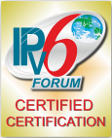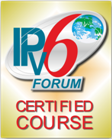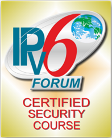Certifications
All Erion IPv6 courses are certified by the IPv6 Forum. Erion also has its own IPv6 certification programme.



The Internet of Things (IoT) is growing at an astounding pace. There is a proliferation of Internet enabled devices, with new ones appearing almost daily. Cars, houses, farms, businesses and public places are all becoming a part of the Internet enabled world. The Internet of Things is changing the way that we live.
IPv6 is playing a crucial role in the growth of the Internet of Things. It provides the required address space for the expected hundreds of billions of Internet enabled devices of the future. Furthermore, IPv6 provides a way to leverage standard Internet protocols all the way from the user to the end device. A form of IPv6 (6LowPAN) makes it possible for sensors and actuators that are small, low-power and cheap, to be connected to the Internet of Things.
Erion's comprehensive 6LowPAN training covers all aspects of 6LowPAN.
In this course, you will learn how to obtain and implement 6LowPAN in a variety of environments and on a number of different platforms.
This course provides extensive hands-on sessions and in-depth technical analysis.
This course is ideal for software and hardware engineers developing sensor networks using 6LowPAN. It is also appropriate for those looking to deploy and manage 6LowPAN based sensor networks.
Most modules include detailed exercises or demonstrations.
All Erion IPv6 courses are certified by the IPv6 Forum. Erion also has its own IPv6 certification programme.



Trainers are practising IPv6 consultants with extensive experience of IPv6 and 6LowPAN. Further information can be found at www.erion.co.uk.
Erion is the world's leading IPv6 training company.
Our courses are available world-wide in our virtual classrooms accompanied by virtual labs. We also deliver on-site training and public training at venues around the world.
Please contact us if you are looking for training in your area.